The types of bees in the garden helping with pollination chores, a popular topic of conversation among gardeners, usually starts and ends with the family Apidae.
Potentially the conversation can last for days because North American hosts approximately one thousand different species, including its most familiar members, honey bees and bumblebees, along with less familiar names such as Cuckoo Bees, Carpenter Bees and Digger Bees. The video at the top of the page shows a group of bumblebees on thistle (joined by a leaf cutter bee). Thistle may be a weed. However, in the wild, it’s a magnet for many bees collecting pollen.

The story of flower bees extends far beyond the basic honeybee. Approximately four thousand bees inhabit North America, and many households who practice bee friendly gardening get treated with their presence and pollination help.
Inviting multiple bee species to the yard relies on two simple tasks. Ecologically bees and native plants evolved together over time, so planting native flora encourages native bees to visit.
White, yellow and blue or UV flowers often attract bees. Additionally the shape of the flower counts. Flat top flowers that allow bees to land and walk, and tubular flowers often do the trick. Some plants do double work. For example, milkweed gets its reputation as the larval food for the monarch butterfly.
Less well known is the fact that it also supports the local bumblebee, honeybee, digger bee, Halictid bee, wasp and flower fly populations.
The popular and omnipresent Purple Coneflower also works wonders attracting bee flies, Halictid bees, honeybees, bumblebees, digger bees and leaf-cutting bees.
Second, news stories about the harms that pesticide use cause to local bee populations consistently appear in the media. Abstaining from pesticides and promoting healthy plant growth will help keep the local bee populations healthy.
Having many types of bees in the garden and neighborhood also helps maintain a health local ecosystem.
Going back to the Apidae bees, it needs to be noted that they rank as star pollinators of backyard gardens and large scale agricultural enterprises. Because they tend to be general pollinators, honeybees hold a special place in the commercial agricultural sector.
Recent research entitled, Pollination of tomatoes by the stingless bee Melipona quadrifasciata and the honey bee Apis mellifera (Hymenoptera, Apidae) (Genetics and Molecular Research 8 (2): 751-757 (2009) decided to compare the pollination abilities of the two bees in a controlled experiment and concluded,
The largest number of fruits (1414 tomatoes) and the heaviest and largest tomatoes, and the ones with the most seeds were collected from the greenhouse with the stingless bees…. The stingless bee, M. quadrifasciata, was significantly more efficient than honey bees in pollinating greenhouse tomatoes.
Many kinds of bees tend to be either specialist pollinators or general pollinators. Squash bees, for example, are always a welcome visitors to gardens that plant any member of the cucurbit family. Specialist native bees not only help in the garden, they also help by contributing to native flora diversity.
Types of Bees: Bumblebees

We enjoy seeing all types of bumble bees moseying around the garden, happy that they are contributing to the pollination of the flowers and/or vegetables. They are easy to recognize as a beneficial genera of bees related to the honey bee. Like honey bees, bumble bee (genus Bombus) colonies consist of a queen, workers and drones. Unlike honey bees, they nest underground
Identifying bumble bee species involves following a set of rules that are similar to other insect identification tasks. Their body consists of a head, thorax and abdomen, and different species show different hair colors and patterns on all three body parts. Maybe easiest place to start with bumblebee identification is by looking at the abdomen. Generally it will have a combination of either black and yellow or black and red hairs.
The top picture of a red-tailed bumblebee (bombus huntii), for example, provides at least half the information any insect enthusiast needs to start the identification process. There are a handful of red-tailed bumblebees in North America, most geographically defined.

The Yellow Faced Bumble Bee in picture two shows both yellow hairs on the face and a small yellow band at the bottom of the abdomen.

California Bumblebee

Compare the Yellow-faced bumble bee with the bumble bee in the picture. They both show yellow hairs on the face. However, the bumble bee in the picture does not show any yellow band on the bottom of the abdomen and it shows a rather thick band of yellow hairs at the top of the abdomen. Those physical features are sufficient to tentatively identify is as a Bombus griseocollis.

Finally, looking again at the abdomen of the bumble bee in the next picture reveals a pattern of yellow and black bands on the abdomen. That’s a good clue for tentatively identifying Bombus Appositus.

The white tail of the Western Bumble Bee (Bombus occidentalis) makes it a fairly easy species to identify. Finding one is an altogether different story.
Once common throughout the Western United States, the population experienced a dramatic decline. Scientists hypothesize that the species contracted a parasitic fungi, Nosema bombi, when it was exported to Europe to create commercial colonies for pollinating greenhouse plants. When the colonies were re-imported, escaped greenhouse species spread the fungus through the native Western Bumble Bee population.
Three different Bombus occidentalis populations are recognized, each with a slightly different look. The Rocky Mountain and Pacific Northwest populations have the white tail. The Rocky Mountain population also has a yellow ring around the middle of the abdomen.
With those general rules in hand, it’s also important to note some difficulties associated with bumble bee identification. First and foremost, a few bumblebee species, including the Eastern Bumblebee (bombus impatiens), the Two-spotted Bumble Bee (bombus bimaculatus), the Half-black Bumble Bee (Bombus vagans) and the Brown-belted Bumble Bee (Bombus griseocollis), share many physical similarities. In areas where they share overlapping territory, it’s easy to confuse them.
Like honeybees, native bumblebee (genus Bombus) populations continue to experience population stress, to one degree or another. Franklin’s Bumblebee (Bombus franklini), a native species of Southern Oregon and Northern California, for example, is listed as critically endangered on the IUCN Red List. Population declines of other native species are also being recorded around the world.
Researchers hypothesize that the introduction of non-native species into the commercial market solely for pollination, also introduced the diseases associated with the commercial bumblebees.
As the commercial bumblebees escaped into the wild, the mites and viruses associated with them began afflicting native bumblebee populations. Increased pesticide use and habitat alteration which reduces the number of native flowering plants associated with native bumblebee species also contributes to bumblebee population stress.
Currently experts count some 46 different types of bumblebee species present in North America. The picture shows a California Bumblebee. To learn more about identifying bumblebees, press the button at the top of the page.
Types of Bees: Carpenter Bees

The Eastern Carpenter Bee (Xylocopa virginica) looks like an over sized version of a bumblebee without a hairy abdomen. Its range extends through most of the eastern half of the United States. Like bumblebees, they are social insects that spend their day pollinating flowers.
Experts from Texas A&M University describe Carpenter Bees as follows.
As pollinators, carpenter bees are generalists in our gardens and landscapes—they may be found foraging on a number of different species. Like their close cousins, the bumblebees, carpenter bees are early morning foragers. Carpenter bees are excellent pollinators of eggplant, tomato and other vegetables and many types of flowers.
As the name suggests they build their nest in wood, which occasionally causes problems in residential areas. A circular hole on the surface of untreated wood, along with a trail of sawdust, are typical indications of carpenter bee activity.
The best way to deal with carpenter bee problems in the home is to discourage them by insuring exterior wood areas such as siding and fences, are either painted or treated with a wood preservative.
Cuckoo Bees

Hairless and small in size, Cuckoo Bees family resemble wasps more than they resemble bees, making them among the least known of the family.
The common name cuckoo refers to the bee’s practice of brood parasitism, like it’s namesake in the bird world, the Cuckoo bird. Adults lay their eggs in ground nests of other bee species, and then let the young fend for themselves.
Digger Bees

Their practice of building nests in soil explains the common name. The picture shows a blue-eyed Digger Bee.
Generally speaking, digger bees are not known to be aggressive bees, thereby reducing the need to remove any nesting sites that may appear in the backyard or near the garden.
Sweat Bees

Moving away from the Apidae family, there’s still many types of bees that help around the garden.
The types of sweat bees in the garden counts over five hundred species arranged in eighteen genera, the sweat bees (family halcitidae) dominate the flower scene in gardens across North America.
Their large population continues to teach scientists much of what they know about social bees. In fact, depending on circumstances, some are social nesters, and others are solitary ground-nesters. Even the ground-nesters show some nesting diversity. For example, what may at first look like a community of nesting sweat bees turns out to be a group of individual bees that share a common nest entrance and then they go on to construct their ow individual nests.
The Metallic Green Bees in the genus Agapostemon rank among the most colorful flower visitors with their iridescent green thorax and striped abdomens.

As the first two pictures show, abdomens with either yellow and black or white on black stripes are common looks for many of Agapostemn species.

Here’s a small, all green sweat bee taking a break from the flowers and consuming some soil nutrients.
Other Bees

The obvious identification question that comes up in any flower bee discussion deals with differentiating between them and flower wasps. Generally the basic rule of thumb that bees are hairy and wasps not hairy. The picture of the small carpenter bee (certina) shows that the rule of thumb does not always apply.
Small carpenter bees can be found from coast to coast. Fortunately, unlike their larger relatives, they do not pose a problem to residential structures. They build their nests in branches and twigs.

An entire family of Mason bees visit flowers on a regular basis. The story of the Wool Carder Bee introduced some additional excitement to an otherwise familiar story. They are a non-native species, recently introduced from Europe, and they have subsequently extended their range from coast to coast. The name refers to the habit of grabbing hairs from plants in order to cushion their nests.
Wool Carder Bees are very territorial. If you take a few moments to watch them, their aggressiveness becomes very apparent. They tend to instantly attack any bee, wasp or fly that comes their way. Fortunately they are not aggressive toward humans and watching the drama play out in the garden can be an interesting exercise.

Blue Orchard bees also fit into the Mason bee family. The name pretty much explains their pollination value. They perform vital services in residential areas with fruit trees.
The picture shows a specimen with mites.

The bee family called Leaf-cutter Bees (Megachile) can sometimes be easily identified by they yellow pollen all over their underside. They lead an interesting life. Their nests are built in the ground and lined with leaves, hence the name. Fortunately they seldom sting.
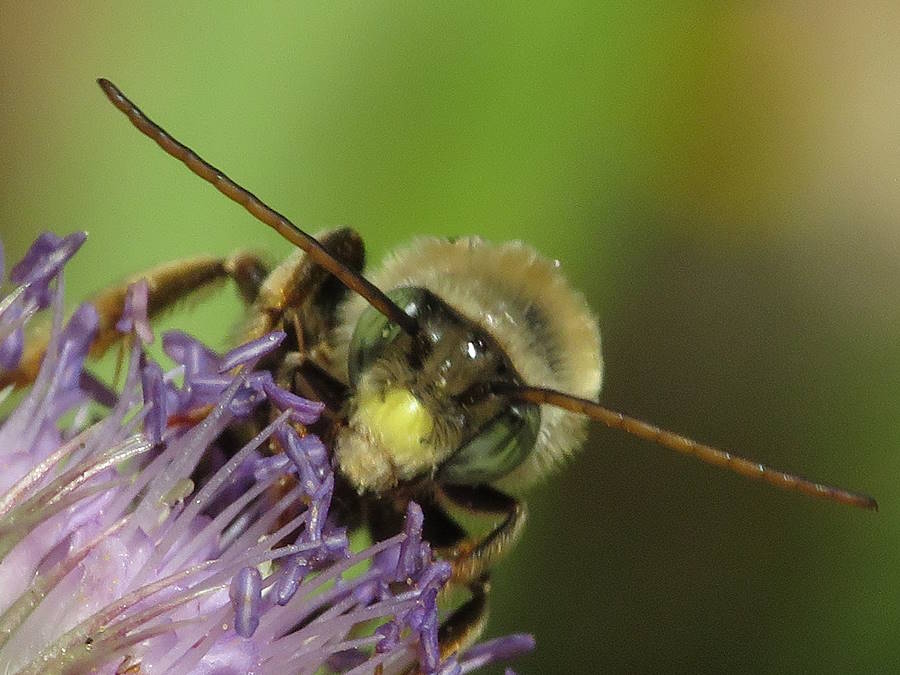
Western Longhorned Bee
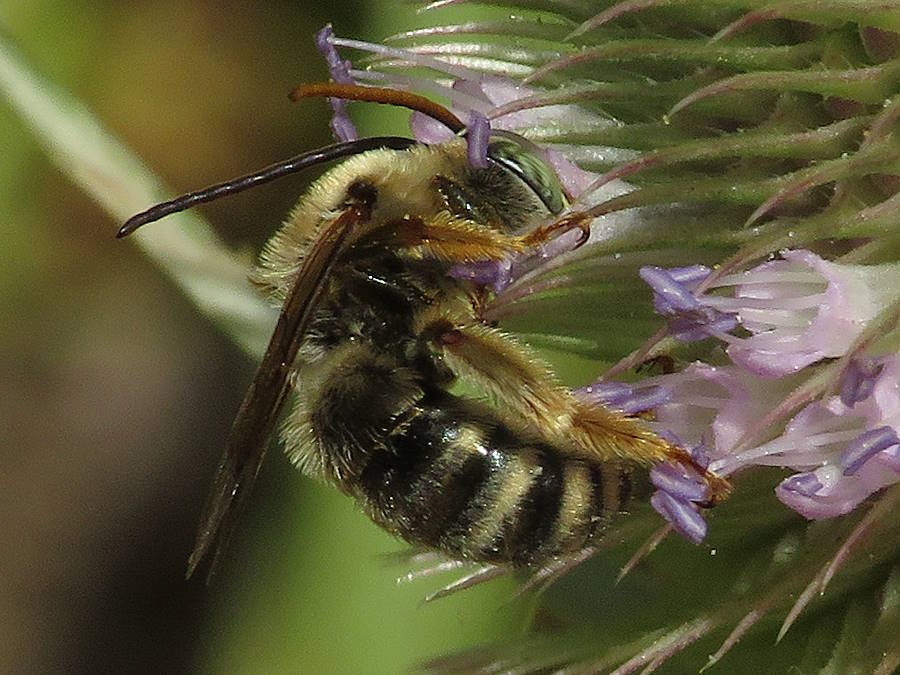
Western Longhorned Bee
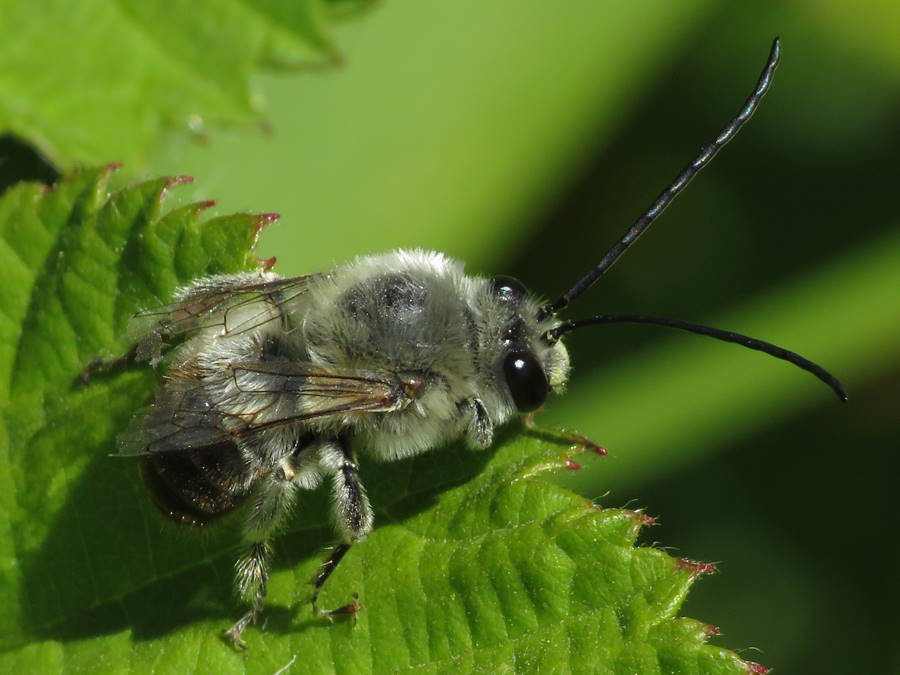
Longhorned Bee

Longhorned Bee
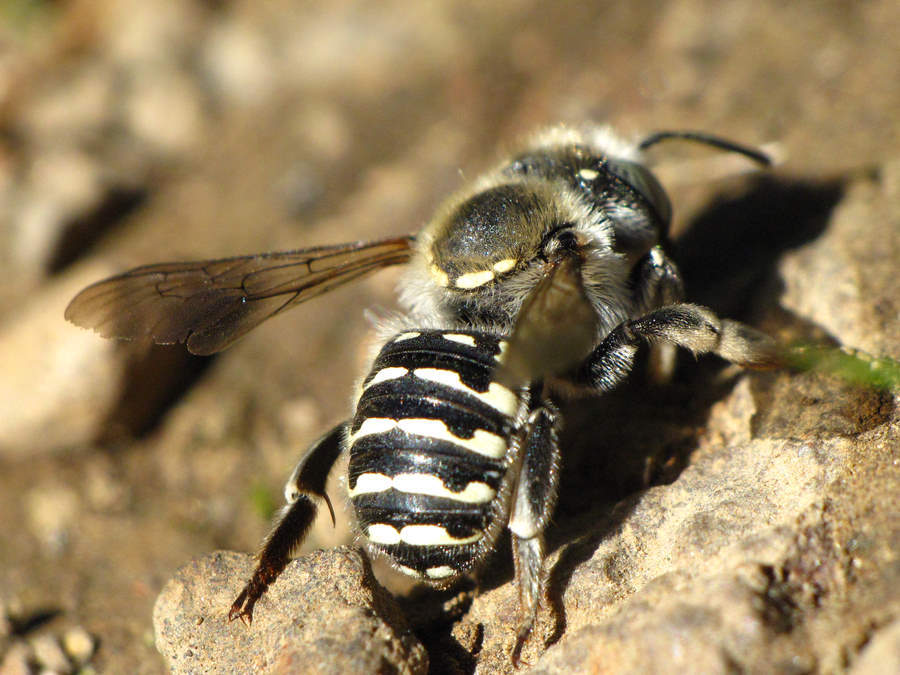
Woolcarder Bee (possibly Anthidium banningense)
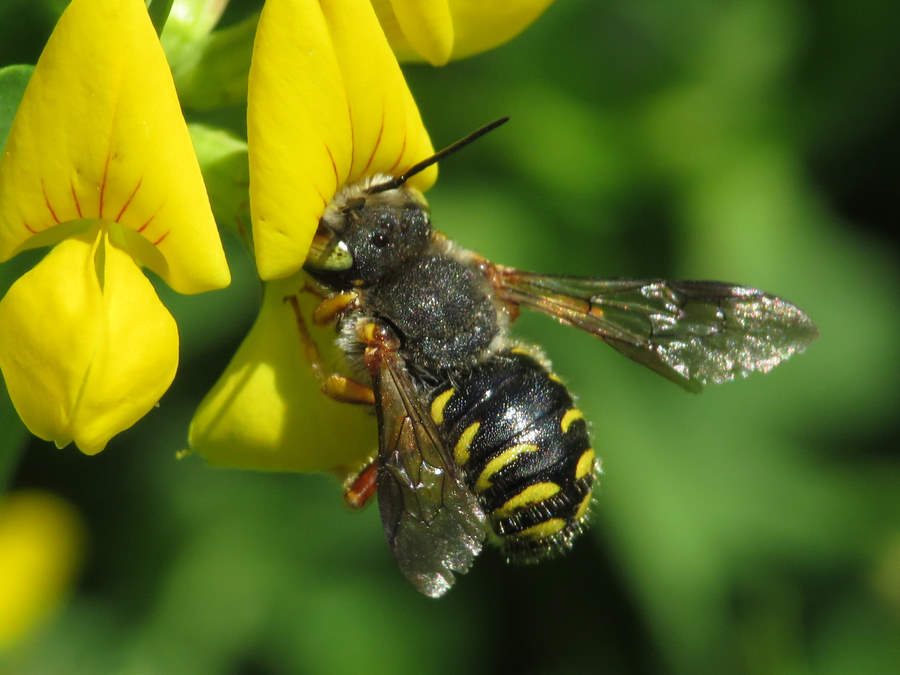
Oblong Woolcarder Bee
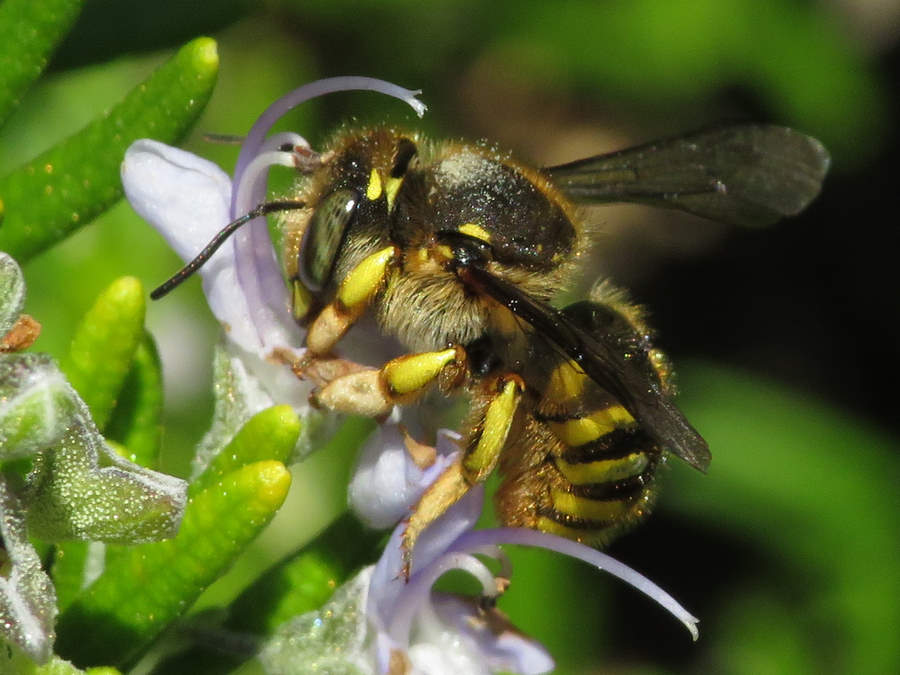
Female European Woolcarder Bee
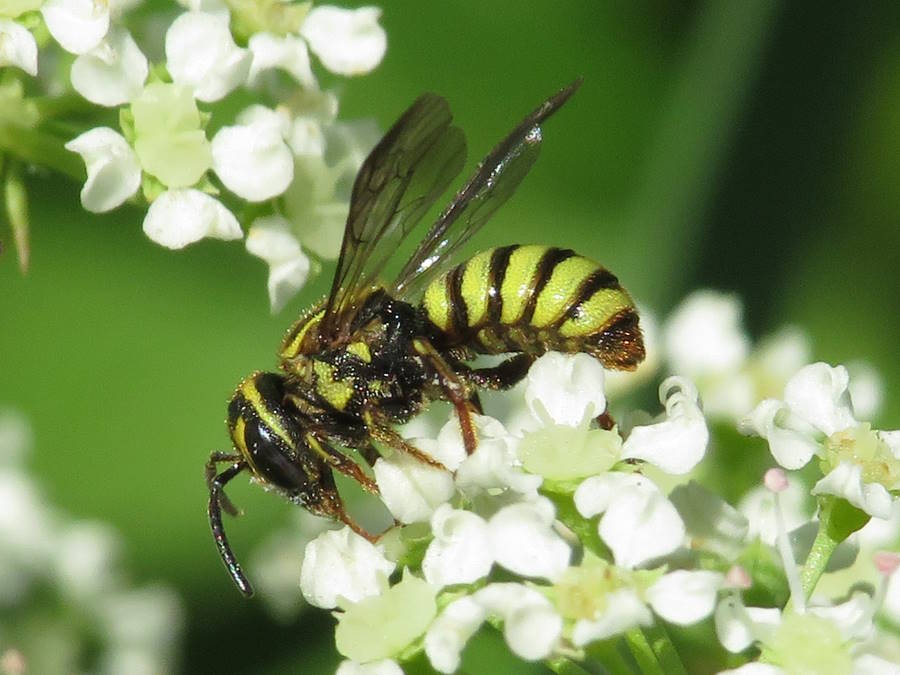
Stelis
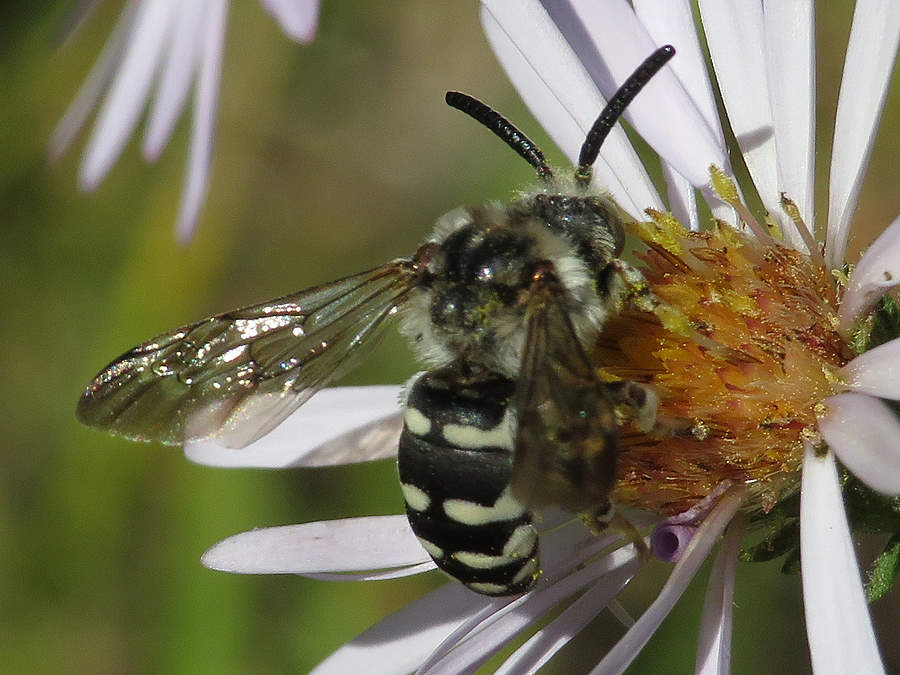
California Digger-cuckoo Bee
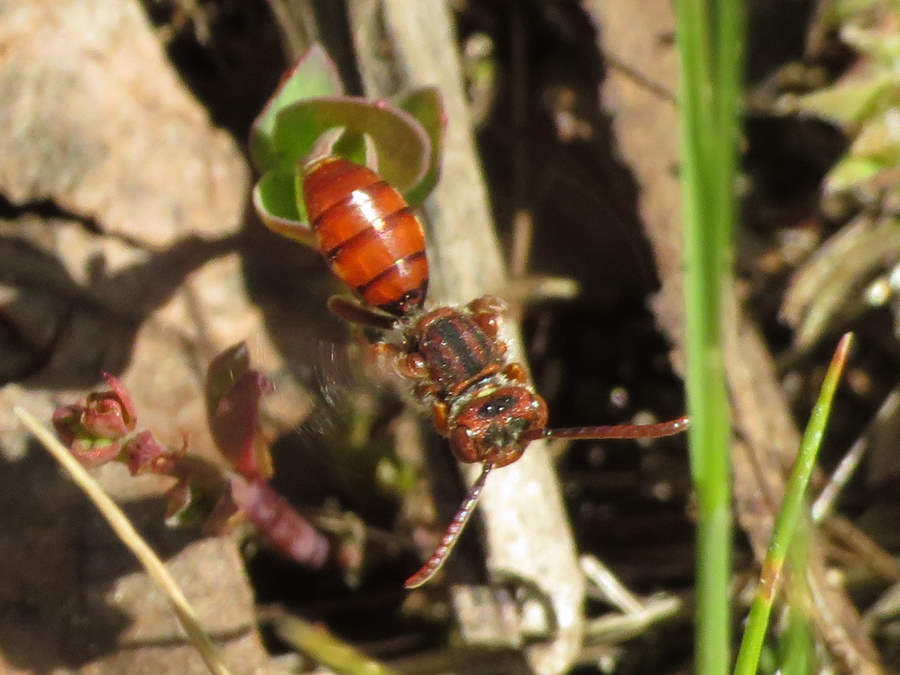
Nomad Bee
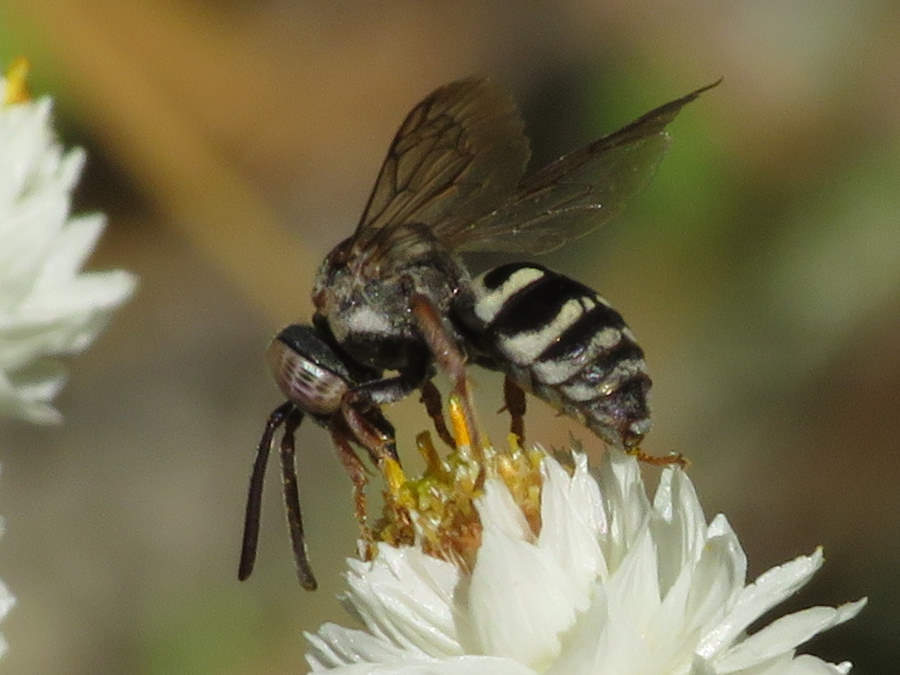
Least Cellophane Cuckoo Bee
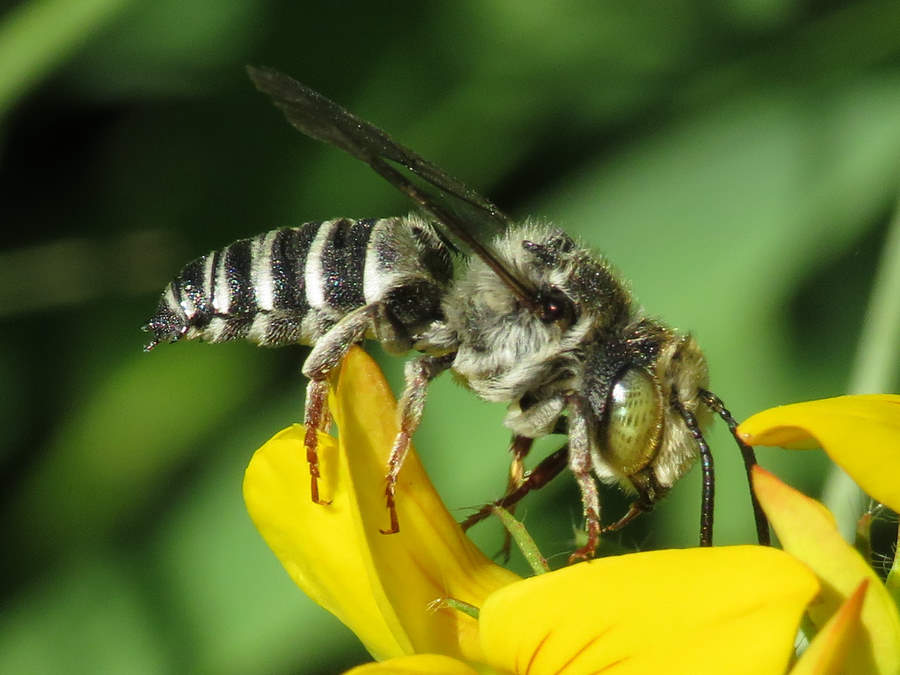
Sharp-tailed Bee
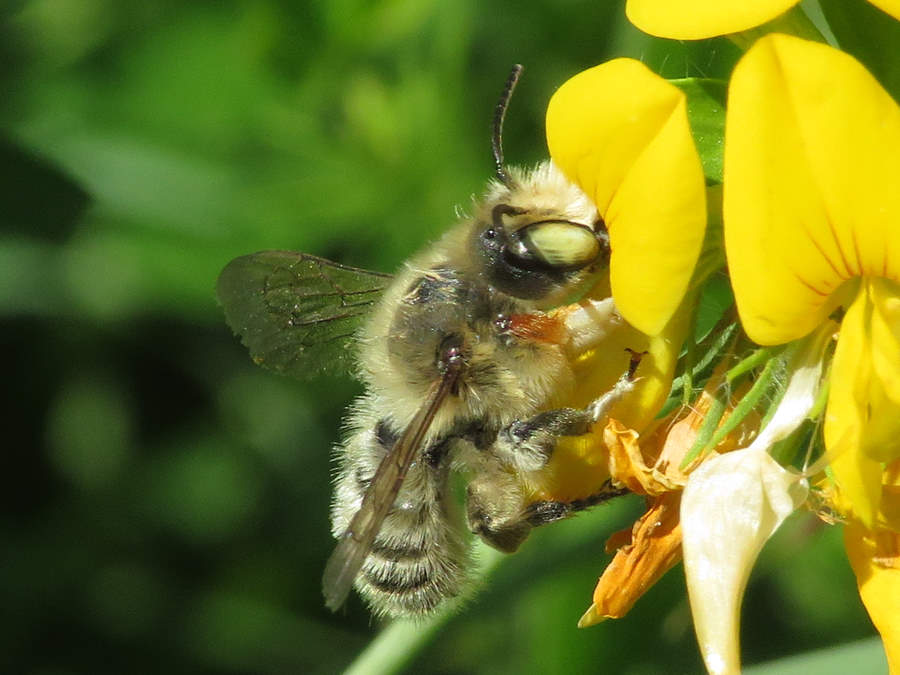
Western Leafcutter Bee
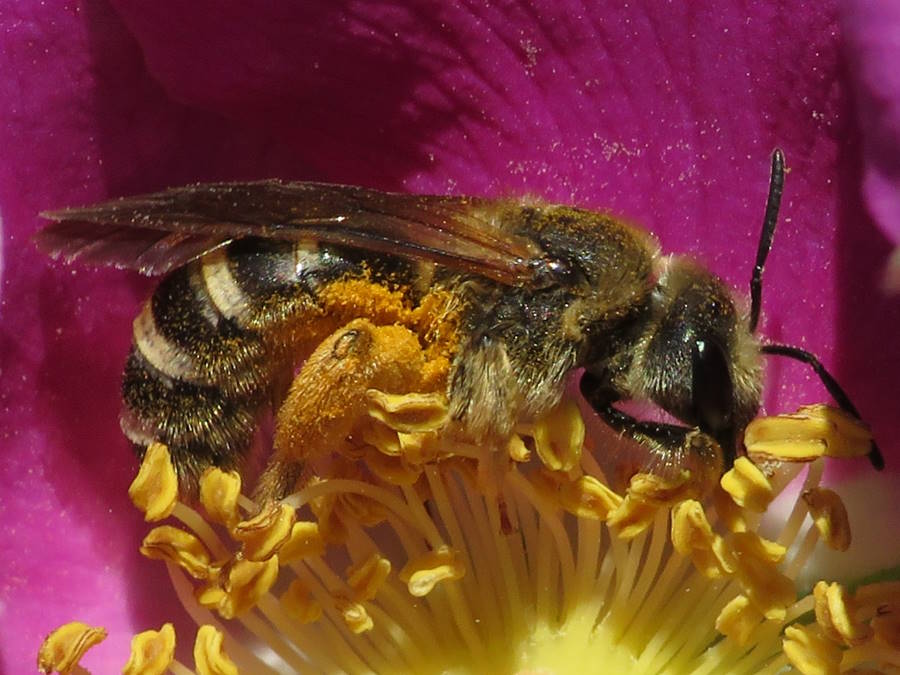
Furrow Bee
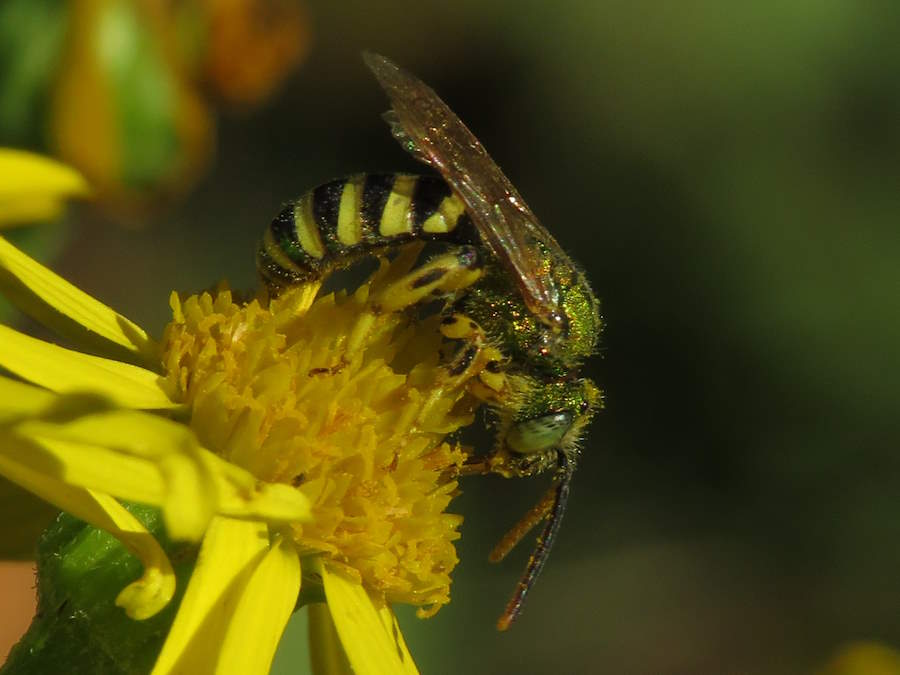
Sweat Bee
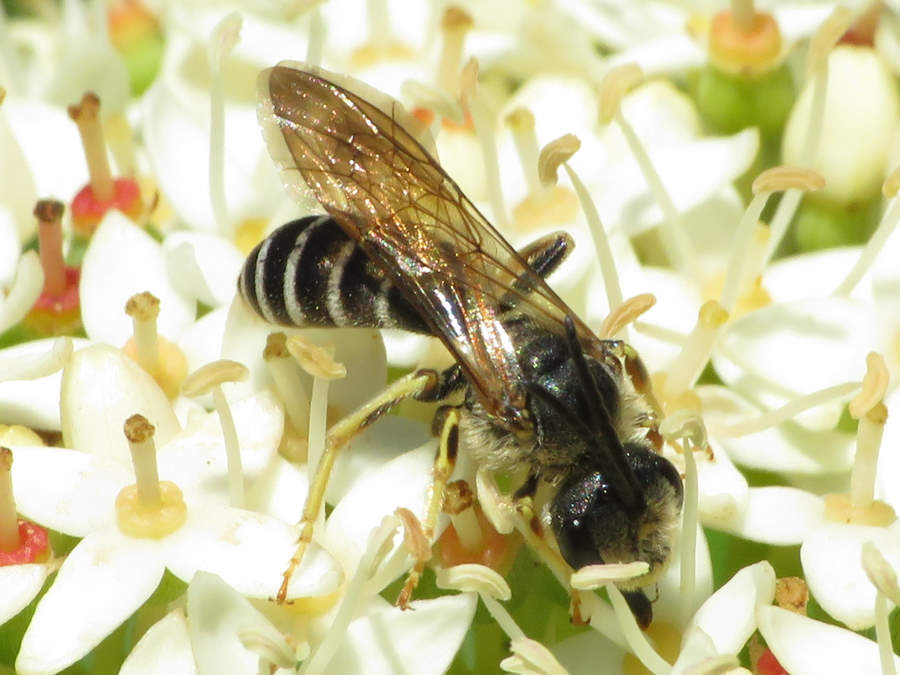
Sweat Bee
